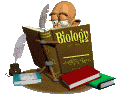| population
density
dispersion
mark-recapture method
clumped
random
uniform
biogeography
demography
age structure
birth rate |
fecundity
death rate
generation time
sex ratio
life table
survivorship curve
life history
semelparity
iteroparity
zero population growth
intrinsic rate of increase |
exponential
population growth
carrying capacity
logistic population
growth
K-selected populations
equilibrial populations
r-selected populations
opportunistic populations
intraspecific competition
density-dependent factor
density-independent
factor
cohort |
| species
richness
relative abundance
species diversity
predation
individualistic hypothesis
interactive hypothesis
secondary succession
interspecific interactions
coevolution
parasitism
parasitoidism
herbivory
community
biogeography
cryptic coloration
aposematic coloration |
mimicry
predator
Batesian mimicry
Mullerian mimicry
parasite
hosts
endoparasites
ectoparasites
interspecific competition
interference competition
exploitative competition
competitive exclusion
principle
ecological niche
fundamental niche
prey
realized niche |
resource
partitioning
character displacement
symbiosis
symbiont
commensalism
mutualism
keystone species
exotic species
stability
disturbances
ecological succession
primary succession
recruitment
dynamic equilibrium
hypothesis
intermediate disturbance
hypothesis |

